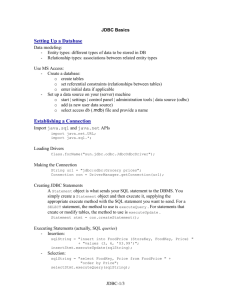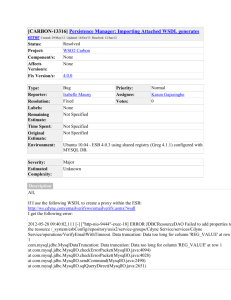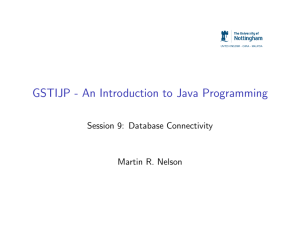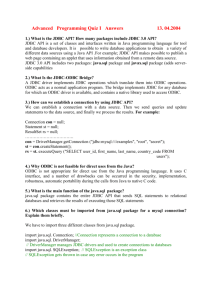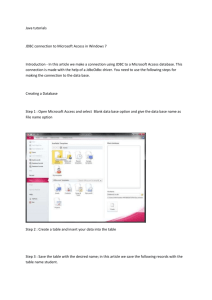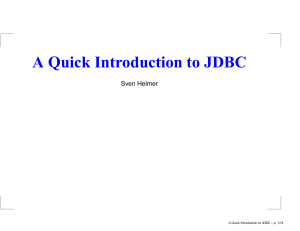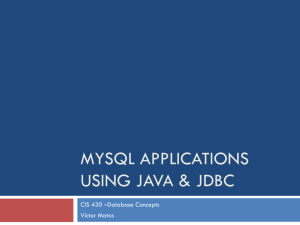Introduction to Java Database Connectivity (JDBC) Technology
advertisement
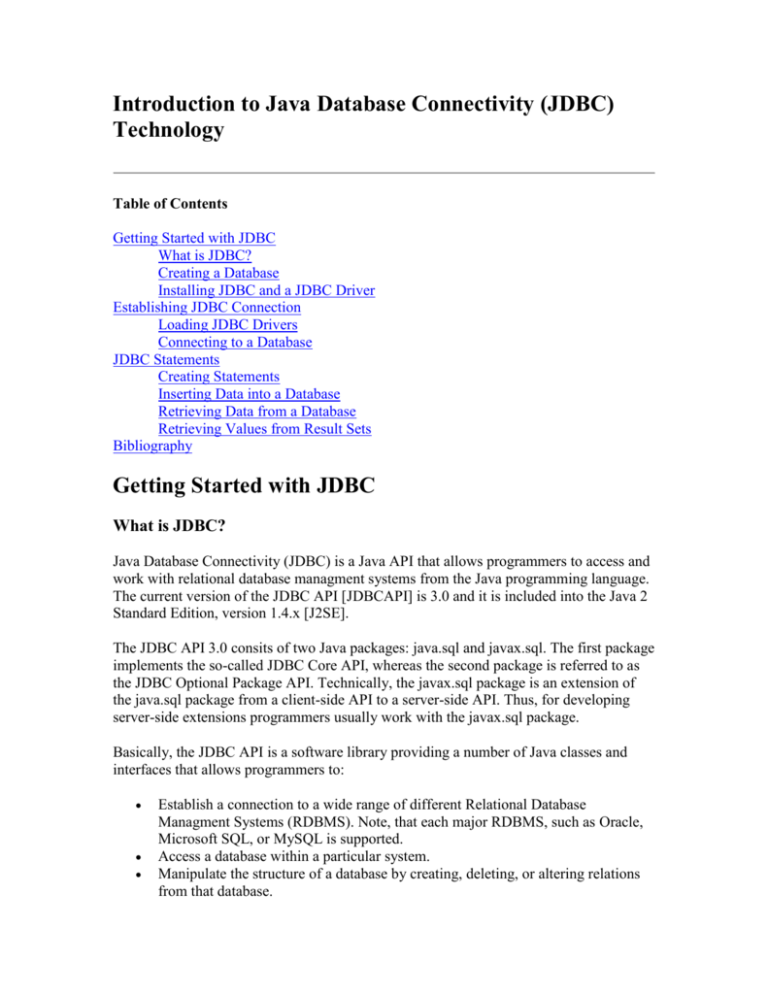
Introduction to Java Database Connectivity (JDBC)
Technology
Table of Contents
Getting Started with JDBC
What is JDBC?
Creating a Database
Installing JDBC and a JDBC Driver
Establishing JDBC Connection
Loading JDBC Drivers
Connecting to a Database
JDBC Statements
Creating Statements
Inserting Data into a Database
Retrieving Data from a Database
Retrieving Values from Result Sets
Bibliography
Getting Started with JDBC
What is JDBC?
Java Database Connectivity (JDBC) is a Java API that allows programmers to access and
work with relational database managment systems from the Java programming language.
The current version of the JDBC API [JDBCAPI] is 3.0 and it is included into the Java 2
Standard Edition, version 1.4.x [J2SE].
The JDBC API 3.0 consits of two Java packages: java.sql and javax.sql. The first package
implements the so-called JDBC Core API, whereas the second package is referred to as
the JDBC Optional Package API. Technically, the javax.sql package is an extension of
the java.sql package from a client-side API to a server-side API. Thus, for developing
server-side extensions programmers usually work with the javax.sql package.
Basically, the JDBC API is a software library providing a number of Java classes and
interfaces that allows programmers to:
Establish a connection to a wide range of different Relational Database
Managment Systems (RDBMS). Note, that each major RDBMS, such as Oracle,
Microsoft SQL, or MySQL is supported.
Access a database within a particular system.
Manipulate the structure of a database by creating, deleting, or altering relations
from that database.
Manipulate the content of a database by inserting, deleting, or updating records in
relations from the database.
Retrieve the content from a database by querying the database.
Creating a Database
To demonstrate the basic capabilities of JDBC we will work with a simple test database.
The following example can be used for that purpose. Suppose we want to develop a
simple database application for a small shop, which sells computer components. The shop
manages a small database keeping the data about its customers, products and sales. Thus,
the database consists of the following domains and relations.
Example 1. Shop Database
Domains
Domain Name Domain Type
cid
Integer
cname
String
ccity
String
cphone
Integer
pid
Integer
pname
String
pprice
Integer
tdate
Date
tqnt
Integer
Relations
Relation Name
Relation Attributes
Customer
(cname, ccity, cphone, cid)
Product
(pname, pprice, pid)
Transaction
(cid, pid, tdate, tqnt)
The database schema will be implemented by means of the open source relational
database managment system MySQL [MySQL]. Here we won't go into details of a
MySQL installation or how to implement a database schema in MySQL. We will suppose
that we have a MySQL server running with the above database schema implemented in a
database with the name "example". For accessing the "example" database on the MySQL
server the username "student" with the pasword "student" has been created. This user
account has the rights to insert, update, and retrieve the data from the database.
Installing JDBC and a JDBC Driver
The latest 3.0 version of JDBC is included in Java 2 Standard Edition, version 1.4.x. For
each particular RDBMS there is a special JDBC driver, which needs to be installed.
Usually, JDBC drivers are installed by following instructions provided by the driver
vendor. In most cases installing JDBC drivers is as simple as copying the compressed
Java Archive (JAR) file containing the driver to a specific directory on your operating
system. Additionally, you will need to include the driver JAR file into the CLASSPATH
environment variable.
The JDBC driver for MySQL is called Connector/J [ConnectorJ]. The current verison is
3.0.9. To set the CLASSPATH variable to point to the Connector/J driver on the Linux
operating system you need to type something like this:
Example 2. Installing Connector/J
#installation in directory /mysql/connector-j
cp mysql-connector-java-3.0.9-stable.jar /mysql/connector-j
#set the CLASSPATH
export CLASSPATH=$CLASSPATH:/mysql/connector-j/mysqlconnector-java-3.0.9-stable.jar
On the Windows operating system you can set the CLASSPATH enviroment variable
from the Control Panel.
Establishing JDBC Connection
Before we can start with manipulating the content of a database with JDBC we need to
establish a connection to that database. Usually, establishing a connection is
accomplished in two steps. Firstly, we need to load the appropriate JDBC driver for the
RDBMS that we have. At the next step we open a connection to a specific database
managed by the system.
Loading JDBC Drivers
Loading a JDBC driver is very simple and involves just a single line of Java code.
Example 3. Loading a JDBC Driver
...
try{
Class.forName("com.mysql.jdbc.Driver");
}catch(ClassNotFoundException exc){
exc.printStackTrace();
}
...
This line of code will tell the DriverManager which Java class to load as a JDBC driver
class. If the specified class can not be found at the CLASSPATH then an exception will
be thrown. The name of the driver class can be found in the documentation of a particular
JDBC driver. In the above example we load the JDBC driver for MySQL RDBMS.
The complete code of the ConnectionManager class, where the MySQL JDBC driver is
loaded is accessible online at
http://coronet.iicm.edu/shop/src/shop/db/ConnectionManager.java.
Connecting to a Database
The next step in establishing a connection to the "example" database is to instruct the
loaded driver to connect to the RDBMS. Again, this can be accomplishe by a single line
of Java code:
Example 4. Loading a JDBC Driver
...
Connection connection_;
...
try{
connection_ = DriverManager.getConnection("jdbc:mysql://" + host +
"/" + db, username, password);
}catch(SQLException exc){
exc.printStackTrace();
}
...
In the above example two new Java classes from the JDBC API are introduced. The first
class is the Connection class. An instance of this class represent a single connection to a
particular database managed by the system. The second class is the DriverManager class,
which provides a number of static class methods for manging JDBC drivers, obtaining
connections, setting parameters of particular connections, and so on.
To create a particular connection to a database we call the getConnection() method of the
DriverManager class. This method takes three arguments:
A JDBC URL, which follows the standard URL syntax. The protocol part starts
always with "jdbc:" folowed by the name of the RDBMS (in our case "mysql")
and terminated with "://" symbols. Thus, the protocol part in our example is
"jdbc:mysql://". The host part identifies the host where the RDBMS is running. In
the case that the Java application connecting to the RDBMS and the system itself
are running on the same machine "localhost" can be used to identify the host.
Otherwise a fully qualified DNS name must be used, such as "coronet.iicm.edu".
Finally, the name of a particular database must be supplied preceeded with the
slash character. In our case this would be "/example".
A registered username that has the proper privileges for manipulating the
database.
Corresponding password for the username.
Note, that a SQLException is thrown if the DriverManager can not connect to the
database for whatever reasons. For example, if the provided database is not existent, or
the user credentials are not correct. The SQLException is a part of the JDBC API.
Again, the complete code of the ConnectionManager class, implementing the above
functionality can be found online at
http://coronet.iicm.edu/shop/src/shop/db/ConnectionManager.java.
JDBC Statements
In order to insert, update, or retrieve data from a database programmers need to work
with instances of the Statement class. The Statement class provides a number of public
methods for executing different commands in the database. Depending on the type of a
particular command the appropriate method should be invoked. For instance, to insert
some data into a relation in a database, the executeUpdate() method should be invoked on
an instance of the Statement class. Similarily, to retrieve data from a database, the
executeQuery() method should be invoked.
Creating Statements
JDBC statements are created by an instance of the Connection class. Thus, the
Connection instance that we created in the previous example can be used to obtain
instances of the Statement class.
Example 5. Creating a JDBC Statement
...
try{
Statement statement = connection_.createStatement();
}catch(SQLException exc){
exc.printStackTrace();
}
...
If an error occurs during the execution of the createStatement() method a SQLException
will be thrown.
The complete code of the Persistent class, implementing the above functionality can be
found online at http://coronet.iicm.edu/shop/src/shop/db/Persistent.java.
Inserting Data into a Database
The Statement class provides a public interface with numerous methods. Depending on
the type of the command that we are submitting to a database we need to choose the
appropriate method and invoke it on an instance of the Statement class. Thus, for
inserting data into a relation of a particular database we need obviously to invoke one of
the executeUpdate() methods. Note, that there exist a number of different
executeUpdate() methods, depending on arguments of the command that we are
submitting to the database. For example, if we need to retrieve the primary keys, which
are generated automatically by the system we need to invoke a special executeUpdate
method. However, if we are not interested in these automatically generated keys, or there
are no keys that are generated automatically we can invoke the most simple
executeUpdate method.
Example 6. Inserting Data into a Relation
...
try{
String insert_sql_stmt = "INSERT INTO " + table + " VALUES(" +
values + ")";
int row = statement.executeUpdate(insert_sql_stmt,
Statement.RETURN_GENERATED_KEYS);
ResultSet keys = statement.getGeneratedKeys();
}catch(SQLException exc){
exc.printStackTrace();
}
...
First of all, we need to create the correpsonding SQL command that will insert the data.
Suppose that the variables "table" and "values" refer to the name of a table in the
database and the values that we want to insert into this table, respectivelly. The final SQL
command is then composed by following the syntax for the INSERT SQL command.
Further, in the above example we retrieve the automatically generated keys. Therefore,
we invoked the appropriate executeUpdate method and passed the
Statement.RETURN_GENERATED_KEYS argument, which guarantees that the newly
generated keys are returned. The generated keys might be then retrieved from the
statement instance by invoking getGeneratedKeys() method. This method returns an
instance of the ResultSet class. More on the ResultSet class, and how its objects are used
to retrieve the database content in the next section. Finally, we need to catch
SQLException again because this exception will be thrown if there an error occurs during
the execution of the executeUpdate method.
The complete code of the Persistent class, implementing the above functionality can be
found online at http://coronet.iicm.edu/shop/src/shop/db/Persistent.java. The above code
is from the store() method.
Retrieving Data from a Database
Similarly, to retrieve data from a database we need to obtain an instance of the Statment
class, and then to invoke executeQuery() method on this instance. This method takes as
an argument the SQL SELECT command representing the query.
Example 7. Retrieving Data from a Database
...
try{
ResultSet query_result = statement.executeQuery(query);
}catch(SQLException exc){
exc.printStackTrace();
}
...
Note, that the "query" argument should contain the appropriate SQL SELECT method.
The executeQuery() method returns an instance of the ResultSet class.
The complete code of the Persistent class, implementing the above functionality can be
found online at http://coronet.iicm.edu/shop/src/shop/db/Persistent.java. The above code
is from the getObjects() method.
Retrieving Values from Result Sets
Generally, execution of any JDBC statement that returns some data from a database
results in an instance of the ResultSet class. This instance contains a number of rows
(records) that hold the current results. The number and type of columns in this object
corresponds to the number and types of columns returned as the result from the database
system. For example, suppose we issue the following SELECT command to the
"example" database.
Example 8. Retrieving Data from a Database
SELECT * FROM Customer;
This SELECT command retrieves all records from the Customer table. Recollect the
definition of the Customer table.
Relations
Relation Name
Relation Attributes
Customer
(cname, ccity, cphone, cid)
Domains
Domain Name Domain Type
cid
Integer
cname
String
ccity
String
cphone
Integer
Thus, executing this SELECT command will result in obtaining an instance of the
ResultSet class which will hold all records from the Customer table as rows. Further,
each row will contain 4 values: cname, ccity, cphone, and cid with types String, String,
Integer, Integer, respectivelly.
The next() Method
Basically, an instance of the ResultSet class is an iterator over the rows it keeps. There is
always the current row, and at a specific moment we can only obtain data from the
current row. If we want to move the cursor to the next row we need to invoke the next()
method. At the beginning, the current row is set before the first row of the result, thus
before we can read data from the first row we must invoke the next() method.
Example 9. Invoking the next() Method
...
try{
ResultSet query_result = statement.executeQuery(query);
while(query_result.next()){
...
}
}catch(SQLException exc){
exc.printStackTrace();
}
...
In the above example we iterate through all the rows contained in the result.
The complete code of the Persistent class, implementing the above functionality can be
found online at http://coronet.iicm.edu/shop/src/shop/db/Persistent.java. The above code
is from the getObjects() method.
The getXXX() Methods
Once when we have the current row of an instance of the ResultSet class, we may invoke
different methods to retrieve the values of the columns. These methods and their names
always correspond to the type of a particular column. Thus, to retrieve the value of a
column with the type String we need to invoke the getString() method. Similarily, to
retrive an integer value we would call the getInt() method.
Example 10. Invoking the getXXX() Methods
...
try{
ResultSet query_result = statement.executeQuery(query);
while(query_result.next()){
String cname = query_result.getString("cname");
...
int cid = query_result.getInt("cid");
...
}
}catch(SQLException exc){
exc.printStackTrace();
}
...
Note, that you need to take care of the appropriate types and the order in which you
invoke the getXXX() methods. If, for instance, you invoke a method which expects a
different column type or name a SQLException will be thrown.
The complete code of the above example can be obtained online at
http://coronet.iicm.edu/shop/src. Alternatively, you may download the complete code as
one compressed file at http://coronet.iicm.edu/shop/src/shop.zip.
Finally, you may acces the online application, which provides a Web interface to access
and manipulate the contebt of the "example" database at http://coronet.iicm.edu/shop/.
Note, that this Web application is implemented by means of the Java Servlet technology.
Bibliography
Online Resources
[J2SE] Java 2 Standard Edition. http://java.sun.com/j2se/.
[JDBCAPI] JDBC API Specification. http://java.sun.com/products/jdbc/download.html.
[MySQL] MySQL Relational Database Managment System. http://www.mysql.com/.
[Connector/J] Connector/J MySQL JDBC Driver. http://www.mysql.com/downloads/apijdbc-stable.html.
